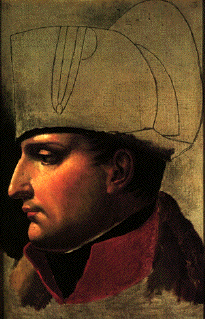|
Famous People

Above is the famous historical
figure of the 18th century from France, Napoleon Bonaparte. His contribution to
France was not only confined to those of military and civil achievement, but of
course including those of dresscode.
The
Representative of France
Official portraits of the king,
following the particularly felicitous example set by Rigaud in his portrait of
Louis XIV, the Sun King, show the sovereign in majesty, surrounded by the
insignia of his royal status- crown,sceptre, the hand of justice - and wearing
clothes from a different age - the white clothes of the Knights of the Holy
Spirit, fossilised by tradition in the fashion of the 16th century, when the
order was created. The white suit is covered by the great royal cloak of blue
with gold fleurs-de-lis (like the French coat of arms) and lined with ermine
whose cut dated back to the Middle Ages. The chain of the order of which the
king was the grand master can be seen glinting on the ermine draped over his
left shoulder. The clothes signify that the person wearing them is the
embodiment of tFrance in all aspects, the avowed defender of his country, around
whom the Order of the Holy Spirit revolved. Rigaud painted the young Louis XV in
the same dress in 1716, when he was only 6 years old and had not yet not been
crowned. The legitimacy and authority of the young king, sometimes called into
question during his regency, were thus proclaimed in advance.
Court
Ceremonial
There was another, quite
different type of costume rubbing shoulders with these medieval costumes at
court. This was worn by courtiers whose function was largely ceremonial -
heralds-at-arms, Swiss guards, the master and grand master of ceremonies, ushers
of the king's bedchamber. The list recalls the enormously increased importance
given to court ceremonial by Henri III, who in 1585 created the position of
grand master of ceremonies. The trunk-hose and short cloak were retained from
that period; the heralds-at-arms, however, replaced the latter with a purple
tabard embroidered with gold fleurs-de-lis.
Finally, the prince carrying the
royal train, the four lords guardian of the Holy Ampulla and the captain of the
Scots guards were clothed in an extravagant version fashion of the day: a velvet
suit trimmed with gold, plus a short cape with a collar, lined with cloth of
gold. This uniform was also worn later at the coronation of Napoleon
I.
Official
Ceremonies
A wedding was another occasion at
which the king and the royal princes had to wear traditional costume, including,
this time, the celebrated trunk hose of the 16th century, always made of some
extravagant fabric. The all-black worn by Louis XIV for his marriage to
Marie-Therese of Spain was abandoned at weddings in the 18th century in favour
of gold and silver. When Louis XV married Marie Leczinska in the Chateau de
Fontainebleau he wore a suit of gold brocade, embroidered in gold and with
diamond buttons. The short cape that he chose instead of a cloak was made of
gold Spanish lace. For his 1st marriage, in 1745, his son wore cloth of
gold with a large pattern of foliage on it, including the jacket, trunk hose and
cloak; the trimmings were in gold lace, enriched with the most valuable pearls
from the crown. In 1770, the future King Louis XVI also wore a suit of cloth of
gold which cost 12,322 lives.
Young royal brides wore clothes
that resembled current court dress more than traditional costume, since the
bride's gown had enormous paniers. Marie Leczinska, who became reigning queen on
her marriage, had the right to wear the royal skirt (jupe) and cloak of
purple velvet edged with ermine and sprigged with gold fleurs-de-lis. Her skirt
was studded with jewels, her whalebone bodice fastened with diamond clasps. The
cloak measured nine ells. Marie-Therese in 1745 and Marie-Antoinette in 1770
were marrying heirs apparent only and therefore had to make do with cloth of
silver - albeit with a long train and trimmed with gold filigree.
In fact, the grand ceremonial
costumes were not used very frequently at court. The king never wore his
coronation robes a second time, even at solemn sittings of parliament, which
were the only occasions when he sat on his throne. At such formal occasions he
wore a 'purple suit and cloak, trimmed with broad bands of embroidery, and wore
a plumed hat on his head'.
Court duties did not necessitate
the wearing of uniform except on coronation day, although the grand master of
ceremonies did wear a cloak of the same colour as his suit and carried a small
baton, covered in black velvet, with an ivory knob.
|